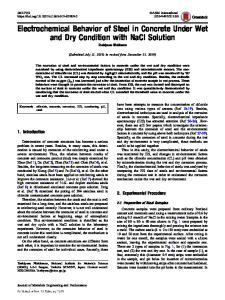Electrochemical Behavior of Three 90Cu-10Ni Tubes from Different Manufacturers After Immersion in 3.5% NaCl Solution
- PDF / 4,256,766 Bytes
- 16 Pages / 593.972 x 792 pts Page_size
- 56 Downloads / 242 Views
JMEPEG DOI: 10.1007/s11665-017-2566-1
Electrochemical Behavior of Three 90Cu-10Ni Tubes from Different Manufacturers After Immersion in 3.5% NaCl Solution Okpo O. Ekerenam, Aili Ma, Yugui Zheng, and Wilfred Emori (Submitted August 2, 2016; in revised form January 5, 2017) Investigation on the electrochemical behavior and corrosion product films formed on three 90Cu-10Ni tubes designated as Tubes A, B and C from three different manufacturers with different service lives were carried out using electrochemical techniques, SEM, XRD and XPS after immersion in 3.5 wt.% NaCl solution. The results of polarization curve measurements showed noticeable decrease in the corrosion current densities (Icorr) of the three tubes with immersion time, and the Icorr of Tube C was comparatively lower than those of Tubes A and B at early immersion period. EIS measurements revealed duplex film layers on the surface of the samples with the inner film formation occurring at different times for different tubes as the film resistance Rf2 revealed the formation of the inner compact layer in Tube C after 15-day immersion and in Tubes A and B after 30 days. Tube C showed better corrosion resistance which is due to early formation of the inner compact oxide film. The XPS analysis revealed Ni enrichment on the surface film of the three samples but Ni depletion as the immersion time is increased. Keywords
corrosion and wear, corrosion product film, EIS, nonferrous metals, oxidation, polarization curves, XPS
1. Introduction Cu-Ni alloys are considered very important commercial alloys in the marine environment. The 90Cu-10Ni alloy has shown good corrosion resistance in seawater, so it has found a wide use in different marine industries such as the heat exchanger tubes in ships (Ref 1). It has been reported that copper-nickel alloys form a homogeneous, a-solid solution over the complete range of Cu-Ni composition (Ref 2). Alloying elements such as nickel and iron are generally accepted to improve corrosion resistance through modification of aged surface oxide layers (Ref 3, 4). The good resistance of the alloy to seawater corrosion is generally attributed to the formation of a protective oxide film on the alloy surface when exposed to seawater (Ref 5-10). This protective oxide film is a duplex layer comprising of an outer layer of cupric hydroxyl chloride, Cu2(OH)3Cl, overlaying a compact inner layer of cuprous oxide, Cu2O, with nickel and iron incorporated occupying cation vacancies and thus increasing the corrosion resistance (Ref 11). However, despite its resistance to seawater corrosion, premature failures of the 90Cu-10Ni alloy tubes are reported frequently after several months of exposure (Ref 12, 13). These failures may be due to (1) external conditions, including water contamination, e.g., hydrogen sulfide ion (Ref 14), higher flow velocity, and/or Okpo O. Ekerenam, Aili Ma, Yugui Zheng, and Wilfred Emori, CAS Key Laboratory of Nuclear Materials and Safety Assessment, Institute of Metal Research, Chinese Academy of Sciences, 62 Wencui Road, Shenyang 11
Data Loading...










